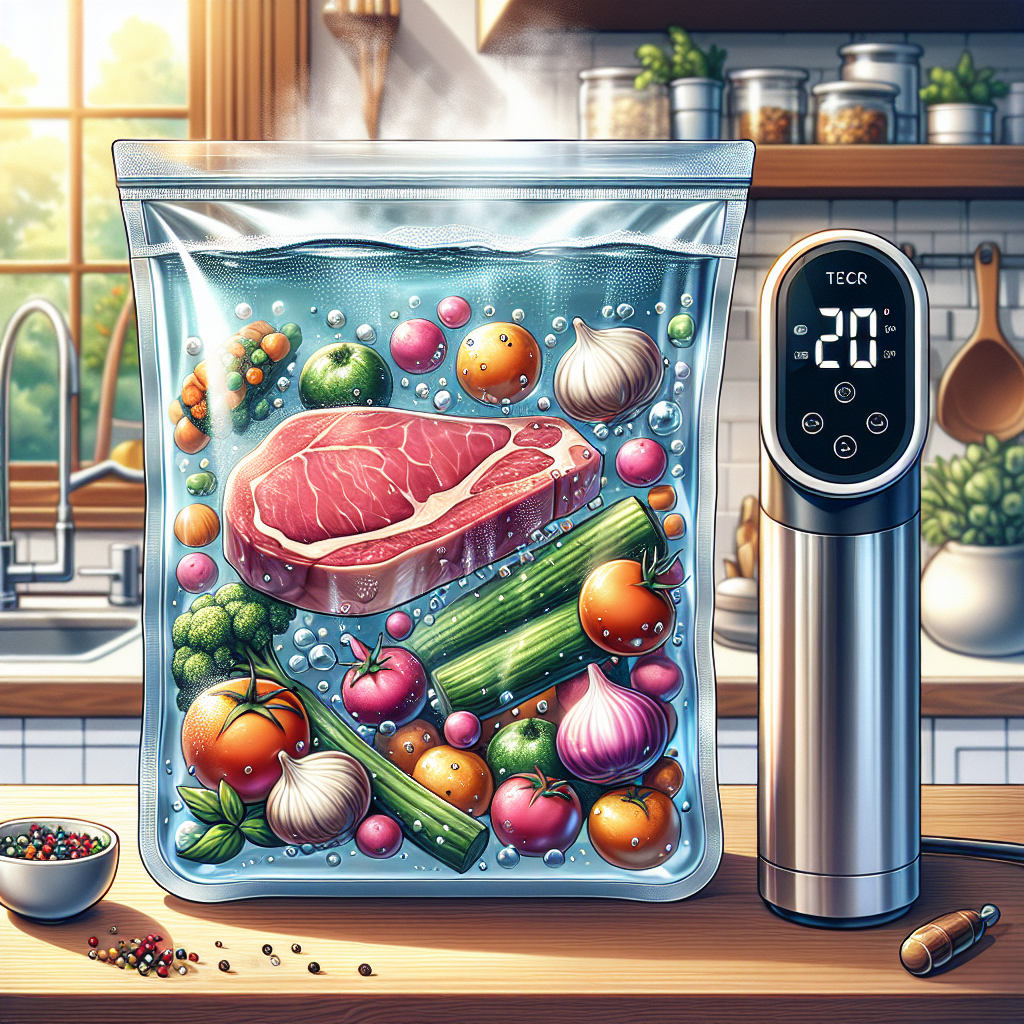
If you’ve ever been curious about using Ziploc bags for sous vide cooking, you’re not alone. Many cooking enthusiasts wonder if these commonly-found bags can withstand the heat and water immersion required for the sous vide method. In this article, we will explore whether Ziploc bags are a suitable option for this popular cooking technique. So, let’s dive right in and find out if you can confidently use Ziploc bags for your sous vide adventures.
What is Sous Vide?
Sous vide is a cooking technique that involves sealing food in a vacuum-sealed bag and cooking it in a water bath at a precise and consistent temperature. This method originated in professional kitchens but has gained popularity among home cooks in recent years.
Definition
Sous vide, which translates to “under vacuum” in French, is a cooking technique that involves placing food in a sealed bag and immersing it in a water bath that is set to a specific temperature. This controlled environment allows the food to cook slowly and evenly, resulting in tender, juicy, and flavorful dishes.
Process
The sous vide cooking process involves three simple steps:
-
Season and seal: Season your food with desired herbs, spices, or marinades. Place the food in a Ziploc bag or vacuum-sealed bag, removing as much air as possible.
-
Water bath setup: Preheat a water bath to the desired temperature using a sous vide machine or immersion circulator. The temperature will depend on the type of food you are cooking.
-
Cook and finish: Submerge the sealed bag into the water bath and cook for the recommended time. Once the cooking is complete, you can finish the food by searing, grilling, or broiling to add texture and color.
Benefits
There are several benefits to cooking sous vide:
-
Precise temperature control: Sous vide cooking allows you to cook food at a consistent temperature, ensuring it is cooked to perfection every time. This control over temperature helps in achieving desired results, especially for delicate proteins like fish and eggs.
-
Enhanced flavor and texture: By cooking food in a sealed bag, the flavors are sealed in, resulting in a more intense and flavorful end product. Additionally, the gentle and controlled cooking process results in tender and juicy textures.
-
No overcooking: With sous vide cooking, the food cannot be overcooked even if it remains in the water bath for longer than the recommended cooking time. This eliminates the risk of ending up with dry or tough food.
-
Convenience: Sous vide cooking is relatively hands-off, allowing you to set it and forget it. This makes it a convenient cooking method for busy individuals or those who want to prepare meals in advance.
Understanding Ziploc Bags
What are Ziploc bags?
Ziploc bags are a popular brand of resealable plastic bags that are commonly used for food storage and preservation. They are made of durable plastic with a resealable zipper-like closure, allowing for easy sealing and opening.
Types of Ziploc bags
Ziploc bags come in various sizes and types, catering to different needs. Some common types of Ziploc bags include:
-
Freezer bags: These bags are thicker and have a double zipper seal, making them ideal for storing food in the freezer.
-
Storage bags: These bags are suitable for general food storage, non-food storage, and organizing small items.
-
Sandwich bags: These smaller-sized bags are designed to hold sandwiches, snacks, or other single-serve portions.
Safety considerations
When using Ziploc bags for sous vide cooking, it is important to be mindful of safety considerations:
-
Use food-grade bags: Ensure that the Ziploc bags you use specifically state they are food-safe and suitable for sous vide cooking.
-
Check for leaks: Before submerging the bag in the water bath, ensure that there are no visible leaks or holes in the Ziploc bag. This can be done by gently squeezing the bag to check for air escaping.
-
Avoid direct contact with open flame or hot surfaces: Ziploc bags are not designed to withstand direct contact with open flames or hot surfaces. Always ensure proper precautions are taken to prevent any accidents or damage.

Benefits of Using Ziploc Bags for Sous Vide
Cost-effective option
One of the major benefits of using Ziploc bags for sous vide cooking is that they are a cost-effective option. Compared to vacuum sealers or specialized sous vide bags, Ziploc bags are readily available at affordable prices.
Readily available
Ziploc bags can be easily found in grocery stores, making them a convenient option for home cooks who may not have access to specialty cooking stores. You can simply purchase them along with your regular grocery shopping.
Convenience and reusability
Ziploc bags offer convenience and ease of use, as they do not require any additional equipment or accessories. They are easy to seal and open, making the cooking process hassle-free. Additionally, Ziploc bags can be washed and reused multiple times, reducing waste and saving money in the long run.
Wide variety of bag sizes
Ziploc bags come in a wide range of sizes, allowing you to choose the appropriate bag size for your specific cooking needs. Whether you are cooking a single portion or a large batch, you can find the perfect size of Ziploc bag to accommodate your food.
Risks and Potential Issues
Temperature limitations
Ziploc bags have temperature limitations and may not be suitable for cooking at extremely high temperatures. It is important to check the temperature rating of the specific Ziploc bag you are using and ensure it can withstand the desired cooking temperature.
Sealing quality
While Ziploc bags provide a convenient sealing option, there is a risk of imperfect seals. It is crucial to ensure a tight seal to prevent any water from entering the bag during the cooking process.
Risk of leaks
Ziploc bags may be prone to leaks, especially when cooking for extended periods or at high temperatures. To minimize the risk of leaks, it is important to inspect the bag for any visible defects or punctures before cooking.
Impact on cooking results
Using Ziploc bags for sous vide cooking may have a slight impact on the final cooking results compared to using vacuum sealers or specialized sous vide bags. The absence of a vacuum-sealed environment may result in slightly different textures or flavors.

Best Practices for Using Ziploc Bags for Sous Vide
To ensure successful sous vide cooking with Ziploc bags, follow these best practices:
Choosing suitable Ziploc bags
Select Ziploc bags that are specifically labeled as safe for sous vide cooking. Look for bags with a thickness suitable for your cooking needs and ensure they can withstand the desired cooking temperature.
Ensuring airtight seal
Pay close attention to the sealing process and ensure a tight and airtight seal. Remove as much air as possible from the bag before sealing by using the water displacement method or a vacuum sealer, if available.
Preventing bag contact with direct heat
To prevent the Ziploc bag from coming into direct contact with hot surfaces, use a rack or a sous vide rack to create a buffer between the bag and the heating element. This helps distribute heat evenly and prevents potential damage.
Providing adequate water circulation
Arrange the Ziploc bags in the water bath in a way that allows for proper water circulation. Avoid overcrowding the bags, as this can result in uneven cooking and prevent the water from circulating effectively.
Alternative Options for Sous Vide Cooking
While Ziploc bags are a popular choice for sous vide cooking, there are alternative options available:
Vacuum sealers
Vacuum sealers are specifically designed for sous vide cooking and offer a more robust sealing mechanism compared to Ziploc bags. They create an airtight seal by removing the air from the bag, resulting in a more controlled cooking environment.
Reusable silicone bags
Silicone bags have gained popularity among eco-conscious cooks as a sustainable and reusable alternative to Ziploc bags. These bags are made of food-grade silicone and can withstand high temperatures, making them suitable for sous vide cooking.
Food-grade vacuum pouches
Food-grade vacuum pouches are another option for sous vide cooking. These pouches are specifically designed to withstand high temperatures and provide an airtight seal. They can be purchased in rolls or pre-cut sizes for convenience.
Vacuum sealing with a water displacement method
If you do not have access to vacuum sealers or specialized bags, you can also use the water displacement method with regular Ziploc bags. This involves partially sealing the bag and slowly submerging it in water, allowing the water to push out the remaining air before fully sealing.

Expert Opinions on Using Ziploc Bags for Sous Vide
Culinary experts and professional chefs have varying opinions on using Ziploc bags for sous vide cooking. Here are some common perspectives:
Culinary experts’ recommendations
Many culinary experts acknowledge that while Ziploc bags may not provide the same level of vacuum sealing as specialized bags, they can be a practical and effective option for home sous vide cooking. The key is to ensure proper sealing and to monitor the cooking process to minimize any potential risks.
Experiences from professional chefs
Professional chefs often rely on vacuum sealers and specialized bags for sous vide cooking in a commercial kitchen setting. They prioritize precision and consistency in their cooking, and therefore opt for equipment that can deliver the most controlled environment for sous vide.
Advantages and disadvantages
The advantages of using Ziploc bags for sous vide cooking include affordability, convenience, and widespread availability. However, the disadvantages include potential sealing issues, temperature limitations, and the possibility of leaks. It ultimately comes down to personal preference and the desired level of precision in cooking.
Tips for Using Ziploc Bags Effectively
To ensure optimal results when using Ziploc bags for sous vide cooking, consider the following tips:
Removing air pockets
Before sealing the Ziploc bag, carefully remove any air pockets to ensure even cooking. You can do this by gently pressing on the bag or using the water displacement method.
Using the water displacement method
If you do not have a vacuum sealer, use the water displacement method to remove air from the bag. Submerge the bag in water, allowing the water to push out the air, and seal the bag once all the air has been expelled.
Double bagging for added security
To minimize the risk of leaks, consider double bagging your food by placing it in one Ziploc bag and then placing that bag into a second Ziploc bag. This provides an extra layer of protection against leaks.
Minimizing contact between food and bag
To prevent potential issues with flavors or textures, you can place a small piece of parchment paper or food-safe plastic wrap between the food and the Ziploc bag. This creates a barrier and helps maintain the integrity of the food.

FAQs about Sous Vide and Ziploc Bags
Can Ziploc bags withstand high temperatures?
Ziploc bags are typically made of polyethylene, which can withstand temperatures up to around 150°F (66°C). However, it is essential to check the specific temperature rating of the Ziploc bags you are using, as different types and brands may have varying heat resistance.
Can you reuse Ziploc bags for sous vide?
Yes, Ziploc bags can be washed and reused for sous vide cooking. Before reusing, ensure they are thoroughly cleaned and inspected for any damage or excessive wear. It is generally advised to avoid reusing bags that have been used to cook raw meats or heavily seasoned foods to prevent cross-contamination.
Are Ziploc bags BPA-free?
Many Ziploc bags are labeled as BPA-free, meaning they do not contain bisphenol A, a potentially harmful chemical. However, it is always advisable to check the packaging or confirm with the manufacturer to ensure the specific Ziploc bags you are using are indeed BPA-free.
Can you sous vide with regular plastic bags?
While it is possible to sous vide with regular plastic bags, it is not recommended, as regular plastic bags may not be able to withstand the high temperatures involved in sous vide cooking. Additionally, they may not provide an airtight or reliable seal, increasing the risk of leaks or food contamination.
Conclusion
Using Ziploc bags for sous vide cooking can be a convenient and cost-effective option for home cooks. While they may have some limitations and potential risks, when used correctly and with proper precautions, Ziploc bags can deliver satisfying results. Consider personal preferences, safety considerations, and desired precision when deciding which method to use for sous vide cooking. Whether you choose to use Ziploc bags, vacuum sealers, or alternative options, sous vide cooking offers a unique and flavorful way to elevate your culinary creations.



